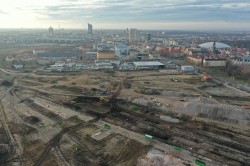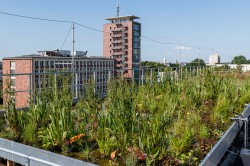Press Release, 20. January 2021
BlueGreen infrastructures for a new and resource-efficient urban neighbourhood
The UFZ is developing a management concept for handling rainwater in a cooperative design effort with the city of Leipzig, businesses and the investor
Leipzig (Germany) is a major city undergoing rapid growth. But this rapid development brings up questions. For example, can urban water and energy infrastructures even handle the additional demands of climate change? For the largest new inner-city district that is to be constructed in Leipzig in the coming years, the Helmholtz Centre for Environmental Research (UFZ) is coordinating a model project throughout Germany in which technologies are being developed that will enable the sensible use and management of rainwater.

Photo: InOneMedia

Photo: André Künzelmann / UFZ
Under the name of "Leipzig 416", the largest inner-city urban quarter in Leipzig, for roughly 3,700 people, is to be developed over the coming years on a site covering 25 hectares - including parks, a campus for a school and sports, offices and cultural and social facilities. More than just affordable housing, both the municipality and the investor also want to develop the neighbourhood based on ecological criteria. The efficient use of resources in terms of managing energy and water in the area play a key part here. In view of the anticipated increased frequency of heavy rains and droughts, it is becoming increasingly important to manage water in the city with a decentralized approach and to maintain the natural water balance. The corresponding concepts are being developed in Leipzig in close cooperation with many participants from business, local government and science.
The UFZ is therefore leading a research group titled "Leipzig BlueGreen - BlueGreen Neighbourhood Development in Leipzig", with participation by the City of Leipzig, the Leipzig public power and water utilities, additional scientific institutions and companies, the German Environment Agency (UBA) and the investor in the district. "We want to show how stress on the central wastewater system can be reduced in an inner-city neighbourhood, energy efficiency can be improved and the effects of heavy rain and drought events can be mitigated," says project leader and environmental biotechnology expert Prof. Roland A. Müller of the UFZ. Decentralized Blue-Green infrastructures such as green roofs, water retention areas and tree pits are planned in the new urban neighbourhood. "These infrastructures can not only significantly reduce stress on the city stormwater sewernetwork by retaining rainwater during heavy rains. With targeted infiltration and storage, they can also keep the rainwater available for irrigation over the dry summer months," says Roland A. Müller. The associated evaporation effects can also help improve the microclimate in the new urban neighbourhood.
The UFZ team in the Leipzig BlueGreen project especially benefits from its many years of research and practical implementation of decentralized water infrastructure systems. For example, in 2006 and 2018, the research team developed a systematic approach for arid world regions such as the Arabian Peninsula that flexibly supplements central storm drain networks with distributed solutions, thereby further protecting the groundwater from pollutants and pathogens and minimizing freshwater usage. In 2018 Roland A. Müller's team was awarded the German Environmental Award from the German Federal Environmental Foundation (DBU). Given the background of climate and demographic change, the potential applications for Europe's rapidly-growing cities were becoming apparent even at that time.
A further key aspect of the "Leipzig BlueGreen" project is the green roofs that have been constructed for research purposes on the UFZ site in Leipzig over the past two years. Scientists from a wide range of technical fields and institutions meet there to investigate the advantages and disadvantages of green roofs of different designs - from roofs bearing marsh plants to evaporation-intensive green roofs, to extensive green roofs. For example, urban climatologists study the details of water and energy balances in the different green roofs, environmental chemists identify the entrainment of airborne pollutants, and biologists identify their different roles in maintaining biodiversity. "It is extremely important for us to know these details if we want to design Blue-Green infrastructures on a large scale," stresses UFZ environmental biotechnology expert Dr. Manfred van Afferden. He is especially excited by their multifunctional aspects: Green roofs can help keep cities at comfortable temperatures, retain the unimpeded runoff of rainwater from the buildings over extended periods, store water for irrigation in the summer, clean up service water from households or street drains or serve as biotopes to promote biodiversity. The water stored in a green roof can also be integrated with heat exchangers to cool rooms inside the buildings.
However, the deployment of Blue-Green facilities within the city is not so straightforward from a legal perspective. "Applicable urban drainage regulations are largely based on the classic model of storm drain systems and is not clear enough in regulating what municipalities and property owners can or must do with regard to distributed alternatives for rainwater infiltration and recycling. There is no forward-thinking regulation that specifically empowers municipalities to plan and implement BlueGreen infrastructures on public or private land," says UFZ environmental law expert Dr. Moritz Reese. His team is developing recommendations for the legal changes that lawmakers should make to enable new solutions to benefit the environment and the public. Under what conditions are distributed systems like green roofs, retention pools and tree pits permitted? What requirements must be considered for groundwater and soil protection? How can flood protection and accident protection be ensured? "We want to help improve the statutory framework to make it easier for municipalities to adopt innovative concepts and to give investors incentives to implement sustainable rainwater management," Reese says. For example, urban planning law, construction planning law and water law have yet to be adequately designed to accommodate distributed technologies.
The City of Leipzig sees it as an advantage that the "Leipzig Blue-Green" project is also being implemented jointly in a cooperative design effort with municipal participants: "We can incorporate our needs and urban planning requirements while simultaneously benefiting from the research results," says Heinrich Neu, head of the Leipzig Urban Planning Department. "District 416 in Eutritzsch represents a blueprint for comparable tasks in urban neighbourhood planning," adds project manager Roland A. Müller. "We are therefore working together with city decision-makers to determine whether and how the research results can be applied to other pending construction projects."
The "Leipzig BlueGreen project - BlueGreen Neighbourhood Development in Leipzig" is funded with roughly EUR 2.8 million by the BMBF funding measure "Resource-Efficient Urban neighbourhoods for the Future (RES:Z)". RES:Z is supporting a total of twelve interdisciplinary and cross-disciplinary projects with the participation of more than 20 model municipalities throughout Germany. Leipzig is the only model city in eastern Germany. Participants in the "Leipzig BlueGreen" project comprise the City of Leipzig, the Leipzig municipal water utility and power utility, Leipzig 416 Management GmbH, the Fraunhofer Institute for Interfacial Engineering and Biotechnology (IGB), the University of Leipzig, the Leipzig University of Applied Sciences (HTWK Leipzig), Tilia GmbH, Optigrün International and DHI Wasy GmbH and the German Environment Agency (UBA).
Further information:
Webseite zum Projekt: www.ufz.de/leipzigerblaugruen/
Further information
Prof. Dr. Roland A. Müller
Head of the UFZ Centre for Environmental Biotechnology (UBZ)
roland.mueller@ufz.de
UFZ press office
Susanne Hufe
Phone: +49 341 6025-1630
presse@ufz.de
In the Helmholtz Centre for Environmental Research (UFZ), scientists conduct research into the causes and consequences of far-reaching environmental changes. Their areas of study cover water resources, ecosystems of the future, environmental technologies and biotechnologies, the effects of chemicals in the environment, modelling and social-scientific issues. The UFZ employs more than 1,100 staff at its sites in Leipzig, Halle and Magdeburg. It is funded by the Federal Government, Saxony and Saxony-Anhalt.
www.ufz.deThe Helmholtz Association contributes to solving major challenges facing society, science and the economy with top scientific achievements in six research fields: Energy; Earth and Environment; Health; Key Technologies; Matter; and Aeronautics, Space and Transport. With some 39,000 employees in 19 research centres, the Helmholtz Association is Germany’s largest scientific organisation.
www.helmholtz.de